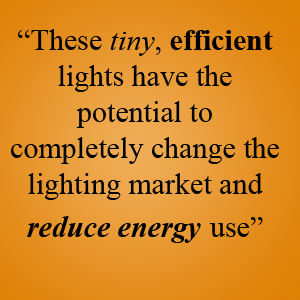Lighting
When we talk about choosing energy efficient light sources for the home, we usually think about incandescent or compact florescent bulbs. After all, incandescent bulbs have been lighting our homes for years, and the compact florescent bulbs are the face of energy efficient lighting. But what about LEDs? These tiny, efficient lights have the potential to completely change the lighting market and your energy profile – even more dramatically than compact florescent bulbs. LEDs have been used since the early 1960s in a variety of advertising and automotive lighting and in traffic signals. Improved technology means they are now suitable for residential and commercial applications.
 What Is An LED?
What Is An LED?
LEDs, or light-emitting diodes, use simple technology to offer bright, white light in any space. LEDs are electronic semiconductor devices, also referred to as solid-state lighting (SSL) devices. LED lighting starts with a tiny diode comprising layers of semi-conducting material. LED packages may contain one diode or multiple diodes usually enclosed in a lens, mounted on a circuit board and packaged in familiar bulb shapes.
Why consider using LEDs?
While LEDs may have a higher initial cost than incandescent and fluorescent sources they offer many advantages – low energy consumption, long life, small size, good optical control, and cold temperature operation for outdoor lighting. They can replace incandescent and compact fluorescent bulbs in many fixtures although the most effective applications involve replacing existing fixtures with those specifically designed for LEDs. Life expectancy of LED sources ranges from 25,000 to 50,000 hours compared to 750-2,000 hours for incandescent and 8,000-10,000 hours for compact fluorescent sources.
The Energy Source
An LED is 10 times more efficient than an incandescent bulb and also better for the environment than compact florescent bulbs. For example, incandescent sources typically produce 10-18 lumens per watt and compact fluorescent bulbs 25-60 lumens per watt. LED technology is continuously improving and in the near future 200 lumens per watt is feasible for many applications The US Department of Energy has declared LEDs the lighting source most likely to make a real impact on the amount of energy used by Americans.
LED Applications
Among the many suitable applications for LEDS are:
- Downlights
- Decorative lighting
- Portable lamps
- Undercabint lighting
- Accent/display lighting
Outdoor fixtures such as bollards, step lighting, pathway accent fixrtures, and landscape lighting.
LEDs are easily adjusted to achieve exactly the level of lighting that you want. Note, however, that not all LEDs are compatible with all lighting controls. Always check the product packaging for manufacturers’ dimming recommendations.
Increased use of LEDs for home and commercial lighting has led industry insiders to predict LEDs could become a $30 billion market by 2025. That’s a lot of light! Will your house make the switch to LED lighting?